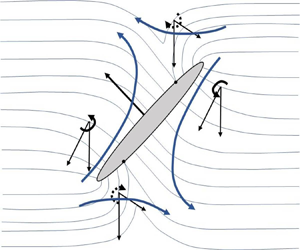Published online by Cambridge University Press: 24 December 2021

We derive analytically the angular velocity of a spheroid, of an arbitrary aspect ratio  $\kappa$, sedimenting in a linearly stratified fluid. The analysis demarcates regions in parameter space corresponding to broadside-on and edgewise settling in the limit
$\kappa$, sedimenting in a linearly stratified fluid. The analysis demarcates regions in parameter space corresponding to broadside-on and edgewise settling in the limit  $Re, Ri_v \ll 1$, where
$Re, Ri_v \ll 1$, where  $Re = \rho _0UL/\mu$ and
$Re = \rho _0UL/\mu$ and  $Ri_v =\gamma L^3\,g/\mu U$, the Reynolds and viscous Richardson numbers, respectively, are dimensionless measures of the importance of inertial and buoyancy forces relative to viscous ones. Here,
$Ri_v =\gamma L^3\,g/\mu U$, the Reynolds and viscous Richardson numbers, respectively, are dimensionless measures of the importance of inertial and buoyancy forces relative to viscous ones. Here,  $L$ is the spheroid semi-major axis,
$L$ is the spheroid semi-major axis,  $U$ an appropriate settling velocity scale,
$U$ an appropriate settling velocity scale,  $\mu$ the fluid viscosity and
$\mu$ the fluid viscosity and  $\gamma \ (>0)$ the (constant) density gradient characterizing the stably stratified ambient, with the fluid density
$\gamma \ (>0)$ the (constant) density gradient characterizing the stably stratified ambient, with the fluid density  $\rho_0$ taken to be a constant within the Boussinesq framework. A reciprocal theorem formulation identifies three contributions to the angular velocity: (1) an
$\rho_0$ taken to be a constant within the Boussinesq framework. A reciprocal theorem formulation identifies three contributions to the angular velocity: (1) an  $O(Re)$ inertial contribution that already exists in a homogeneous ambient, and orients the spheroid broadside-on; (2) an
$O(Re)$ inertial contribution that already exists in a homogeneous ambient, and orients the spheroid broadside-on; (2) an  $O(Ri_v)$ hydrostatic contribution due to the ambient stratification that also orients the spheroid broadside-on; and (3) a hydrodynamic contribution arising from the perturbation of the ambient stratification whose nature depends on
$O(Ri_v)$ hydrostatic contribution due to the ambient stratification that also orients the spheroid broadside-on; and (3) a hydrodynamic contribution arising from the perturbation of the ambient stratification whose nature depends on  $Pe$;
$Pe$;  $Pe = UL/D$ being the Péclet number with
$Pe = UL/D$ being the Péclet number with  $D$ the diffusivity of the stratifying agent. For
$D$ the diffusivity of the stratifying agent. For  $Pe \ll 1$, this contribution is
$Pe \ll 1$, this contribution is  $O(Ri_v)$ and orients prolate spheroids edgewise for all
$O(Ri_v)$ and orients prolate spheroids edgewise for all  $\kappa \ (>1)$. For oblate spheroids, it changes sign across a critical aspect ratio
$\kappa \ (>1)$. For oblate spheroids, it changes sign across a critical aspect ratio  $\kappa _c \approx 0.41$, orienting oblate spheroids with
$\kappa _c \approx 0.41$, orienting oblate spheroids with  $\kappa _c < \kappa < 1$ edgewise and those with
$\kappa _c < \kappa < 1$ edgewise and those with  $\kappa < \kappa _c$ broadside-on. For
$\kappa < \kappa _c$ broadside-on. For  $Pe \ll 1$, the hydrodynamic component is always smaller in magnitude than the hydrostatic one, so a sedimenting spheroid in this limit always orients broadside-on. For
$Pe \ll 1$, the hydrodynamic component is always smaller in magnitude than the hydrostatic one, so a sedimenting spheroid in this limit always orients broadside-on. For  $Pe \gg 1$, the hydrodynamic contribution is dominant, being
$Pe \gg 1$, the hydrodynamic contribution is dominant, being  $O(Ri_v^{{2}/{3}}$) in the Stokes stratification regime characterized by
$O(Ri_v^{{2}/{3}}$) in the Stokes stratification regime characterized by  $Re \ll Ri_v^{{1}/{3}}$, and orients the spheroid edgewise regardless of
$Re \ll Ri_v^{{1}/{3}}$, and orients the spheroid edgewise regardless of  $\kappa$. Consideration of the inertial and large-
$\kappa$. Consideration of the inertial and large- $Pe$ stratification-induced angular velocities leads to two critical curves which separate the broadside-on and edgewise settling regimes in the
$Pe$ stratification-induced angular velocities leads to two critical curves which separate the broadside-on and edgewise settling regimes in the  $Ri_v/Re^{{3}/{2}}$–
$Ri_v/Re^{{3}/{2}}$– $\kappa$ plane, with the region between the curves corresponding to stable intermediate equilibrium orientations. The predictions for large
$\kappa$ plane, with the region between the curves corresponding to stable intermediate equilibrium orientations. The predictions for large  $Pe$ are broadly consistent with observations.
$Pe$ are broadly consistent with observations.